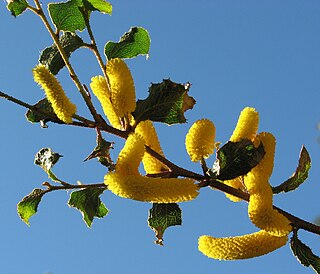
Acacia denticulosa, commonly known as sandpaper wattle, is a species of Acacia native to the south-west of Western Australia. A spindly shrub 1–4 m high, it flowers from September to October, producing dense, curved, yellow flower spikes.

Acacia brachypoda, known colloquially as western wheatbelt wattle or Chinocup wattle, is an endangered species of Acacia restricted to a small locality in western Australia's wheatbelt.
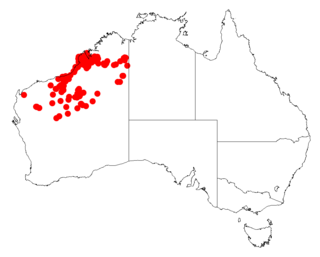
Acacia eriopoda, commonly known as the Broome pindan wattle and the narrow-leaf pindan wattle, is a species of wattle in the legume family that is native to northern Western Australia. It is also known as Yirrakulu to the Nyangumarta peoples.

Acacia ancistrocarpa, commonly known as fitzroy wattle, is a shrub belonging to the genus Acacia and the subgenus Juliflorae. The shrub is also known as fish hook wattle, pindan wattle and shiny leaved wattle.

Acacia jibberdingensis, also known as Jibberding wattle or willow-leafed wattle, is a shrub or tree belonging to the genus Acacia and the subgenus Juliflorae that is endemic to Western Australia.

Acacia calcarata is a shrub belonging to the genus Acacia and the subgenus Phyllodineae.

Acacia excentrica is a shrub belonging to the genus Acacia and the subgenus Phyllodineae native to Western Australia.
Acacia leptalea, commonly known as Chinocup wattle, is a shrub belonging to the genus Acacia and the subgenus Phyllodineae that is endemic to a small area in south western Australia. It is listed as threatened according to the Environment Protection and Biodiversity Conservation Act 1999.

Acacia pachyacra is a tree or shrub belonging to the genus Acacia and the subgenus Phyllodineae. that is endemic to arid parts of central and western Australia.
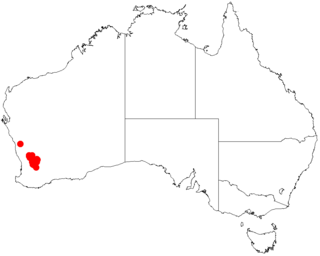
Acacia phaeocalyx is a shrub belonging to the genus Acacia and the subgenus Phyllodineae that is endemic to south western Australia.
Acacia pygmaea, commonly known as the dwarf rock wattle, is a shrub of the genus Acacia and the subgenus Phyllodineae that is endemic to south western Australia.

Acacia vassalii, commonly known as Vassal's wattle, is a shrub of the genus Acacia and the subgenus Phyllodineae that is endemic to a small area of south western Australia. It is listed as critically endangered with the World Conservation Union, as endangered according to the Environment Protection and Biodiversity Conservation Act 1999 and as rare flora with the Wildlife Conservation Act 1950 in Western Australia.

Acacia fragilis is a shrub of the genus Acacia and the subgenus Plurinerves that is endemic to south western Australia.
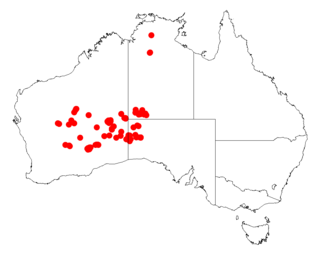
Acacia helmsiana, commonly known as Helm's wattle, is a shrub of the genus Acacia and the subgenus Plurinerves that is endemic to arid areas of central and western Australia.

Acacia lanuginophylla, or woolly wattle, is a shrub of the genus Acacia and the subgenus Plurinerves that is endemic to south western Australia. It is currently listed as a vulnerable species according to the Environment Protection Biodiversity Conservation Act 1999.

Acacia lobulata, commonly known as Chiddarcooping wattle, is a shrub of the genus Acacia and the subgenus Plurinerves that is endemic to a small area of south western Australia. It was declared as rare flora in 1997 and is now listed a Endangered under the Environment Protection and Biodiversity Conservation Act 1999.
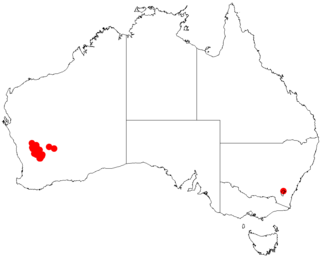
Acacia obtecta is a shrub of the genus Acacia and the subgenus Plurinerves that is endemic to a small area in south western Australia.

Acacia pharangites, commonly known as Wongan gully wattle, is a shrub of the genus Acacia and the subgenus Plurinerves that is endemic to a small area of south western Australia and is listed as endangered according to the Environment Protection and Biodiversity Conservation Act 1999.

Acacia confluens, commonly known as wyrilda, is a shrub belonging to the genus Acacia and the subgenus Phyllodineae that is endemic to central Australia.

Acacia gracilifolia, commonly known as graceful wattle, is a shrub belonging to the genus Acacia and the subgenus Plurinerves native to a small area of central southern Australia.



















